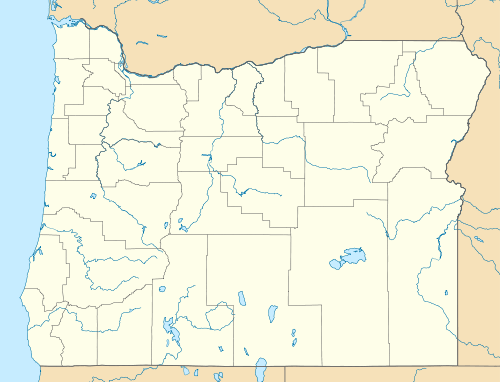Kingsley Field Air National Guard Base
| Kingsley Field Air National Guard Base | |
|---|---|
| Part of Oregon Air National Guard | |
| Located near: Klamath Falls, Oregon | |
|
An F-15 Eagle from the 173rd Fighter Wing (FW), Oregon Air National Guard | |
| Coordinates | 42°09′22″N 121°43′59″W / 42.15611°N 121.73306°W |
| Site information | |
| Controlled by |
|
| Site history | |
| Built | 1928 |
| In use | 1954-Present (USAF use) |
| Garrison information | |
| Garrison |
 173d Fighter Wing |
| Airfield information | |||||||||||||||
|---|---|---|---|---|---|---|---|---|---|---|---|---|---|---|---|
| IATA: LMT – ICAO: KLMT | |||||||||||||||
| Summary | |||||||||||||||
| Elevation AMSL | 4,095 ft / 1,248 m | ||||||||||||||
| Coordinates | 42°09′22″N 121°43′59″W / 42.15611°N 121.73306°WCoordinates: 42°09′22″N 121°43′59″W / 42.15611°N 121.73306°W | ||||||||||||||
| Website | www.173fw.ang.af.mil | ||||||||||||||
| Map | |||||||||||||||
 KLMT Location of Kingsley Field Air National Guard Base | |||||||||||||||
| Runways | |||||||||||||||
| |||||||||||||||
Kingsley Field Air National Guard Base is the home base of the Oregon Air National Guard's 173d Fighter Wing (173 FW).[1]
Overview
The 173d Fighter Wing (FW) of the Oregon Air National Guard occupies 61 acres (25 ha) of leased land on the Klamath Falls Airport, located approximately 4 miles (6.4 km) southeast of Klamath Falls, Oregon. The mission of the 173 FW is to train the best air-to-air combat pilots, train flight doctors and serve Oregon and the Nation in times of peace and war. As an Air National Guard unit, the 173 FW is operationally-gained by the Air Education and Training Command (AETC) and currently flies the single seat F-15C and twin-seat F-15D Eagle. With the conversion of the 325th Fighter Wing at Tyndall AFB, Florida to strictly F-22 Raptor training, the 173 FW assumed all F-15C/D Formal Training Unit (FTU) responsibilities for the U.S. Air Force, to include Regular Air Force and international/foreign military training in addition to Air National Guard F-15 training.[1]
The 173rd FW occupies 5 administrative, 1 dorm, 1 services and 66 industrial buildings totaling approximately 484,981 square feet (45,056.2 m2) with 485 full-time personnel. A unit training drill is conducted once a month and results in a surge of up to a total of 1,235 personnel.[1] This number is exclusive of personnel on temporary duty to Kingsley Field for F-15 formal training or any of a number of periodic air exercises.
In 1928, the citizens of Klamath Falls approved the sale of $50,000 worth of bonds to construct an airport. The airport was known as the Klamath Falls Municipal Airport and consisted of gravel runways and one Fixed Base Operator. In 1942, the airport was selected as a site for a Naval Air Station. Known as NAS Klamath Falls during World War II, the airport was transferred from the U.S. Navy back to civilian use in late 1945.[1]
In 1954, the airport was selected as a site for United States Air Force base and the airfield returned to military control. The former naval air station was then placed under the jurisdiction of the Air Defense Command (ADC). The 408th Fighter Group (Air Defense) was activated at Klamath Falls Municipal Airport on 8 April 1956, being assigned to the 28th Air Division.[2]
In 1957, the airport was dedicated as Kingsley Field in honor of Lieutenant David Kingsley, USAAF. David R. Kingsley, an Oregon World War II hero, was killed in action on June 23, 1944 after a B-24 bombing mission over the oil fields of Ploesti, Romania.[1] The 827th Aircraft Control and Warning Squadron (later 827th Radar Squadron) was activated at Kingsley Field in 1957.[2] While the administrative and support portions of the squadron were located on the airfield, the squadrons operational element and radars were located nearby at what was named Keno Air Force Station in February 1959.[2]
ADC reassigned Kingsley Field to the 25th Air Division on 1 March 1959; transferred to Portland Air Defense Sector on 15 April 1960; transferred to 26th Air Division on 1 April 1966; reassigned to 25th Air Division on 15 September 1969. The 408th Fighter Group was inactivated on 1 October 1970.[2]
Operational ADC fighter-interceptor squadrons which operated from Kingsley Field were:[2]
- 518th Fighter-Interceptor Squadron, 8 June 1956-1 July 1959 (nonoperational)[3]
- 322d Fighter-Interceptor Squadron, 1 April 1959-30 September 1968 (F-101B Voodoo)
- 59th Fighter-Interceptor Squadron, 30 September 1968-17 December 1969 (F-102A/B Delta Dagger)
- 460th Fighter-Interceptor Squadron, 1 December 1969-16 April 1971 (F-106A/B Delta Dart)
The 827th Radar Squadron operated Ground Control-Intercept (GCI) radar from nearby Keno Air Force Station, receiving host station services and support from Kingsley Field, 1 September 1957-1 October 1979.[2]
In 1978, the Department of Defense chose to close Kingsley Field as an active duty Air Force installation as part of the phaseout of the Aerospace Defense Command (ADC) and the transfer of its personnel and assets to Tactical Air Command (TAC). The installation was transferred to Air National Guard control for fighter operations and it has been operated by the Oregon Air National Guard ever since.[1]
References
![]() This article incorporates public domain material from websites or documents of the Air Force Historical Research Agency.
This article incorporates public domain material from websites or documents of the Air Force Historical Research Agency.
External links
| Wikimedia Commons has media related to Kingsley Field Air National Guard Base. |

